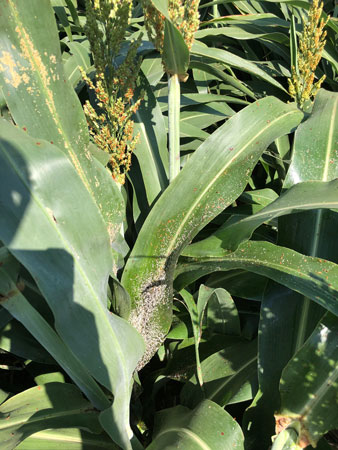Sorghum aphids (Melanaphis sorghi), previously called sugarcane aphids (Melanaphis sacchari), have been reported in two counties in Kansas (Sedgwick and Pottawatomie). These counties are highlighted in green in Figure 1. While not shown on the map, a report from Ellsworth County was received on Thursday afternoon (Figure 2). Grain sorghum producers in Kansas should be scouting their fields on a routine basis.

Figure 1. Current status of the SCA (now called sorghum aphid). The map indicates only the counties in which the SCA has been found, and does not indicate how many or how few aphids were found in that county. Source: https://www.myfields.info/pests/sugarcane-aphid

Figure 2. Sorghum aphids (formerly called sugarcane aphids) in a sorghum field in Ellsworth County, Kansas. Photo by Craig Dinkel, K-State Research and Extension.
Scouting time for SCA
Early detection is key to the management of this pest, but treatments should be based on established thresholds. One heavily infested plant does not equal a yield loss. Applying insecticides too soon can result in repeated applications.
Plants are vulnerable to infestation by SCA at any growth stage, but Kansas sorghum is most at risk from boot stage onward. The ability of sugarcane aphid to overwinter on Johnsongrass and re-sprouting sorghum stubble represents challenges to the management of this pest in more southerly regions.
Issues arising from SCA in Kansas are likely to become increasingly uncommon with each passing year. It is best practice to scout late-planted fields, as these are more susceptible to yield loss and aphids and this a bigger window for aphids to build to damaging levels later in the season.
Sampling method
- Once a week, walk 25 feet into the field and examine plants along 50 feet of row:
- If honeydew is present, look for SCA on the underside of a leaf above the honeydew.
- Inspect the underside of leaves from the upper and lower canopy from 15–20 plants per location.
- Sample each side of the field as well as sites near Johnsongrass and tall mutant plants.
- Check at least 4 locations per field for a total 4 locations per field for a total of 60-80 plants.
If no SCA are present, or only a few wingless/winged aphids are on upper leaves, repeat this sampling method once a week thereafter.
If SCA are found on lower or mid-canopy leaves, begin twice-a-week scouting. Use the same sampling method, but be sure to include % plants with honeydew. Estimate the % of infested plants with large amounts of SCA honeydew (shiny, sticky substance on leaf surface) to help time foliar insecticides for SCA control on sorghum (Table 1).
Table 1. SCA Thresholds
|
Growth Stage |
Threshold |
|
Pre-Boot |
20% plants infested with localized area of heavy honeydew and established aphid colonies |
|
Boot |
20% plants infested with localized area of heavy honeydew and established aphid colonies |
|
Soft dough |
30% plants infested with localized area of heavy honeydew and established aphid colonies |
|
Dough |
30% plants infested with localized area of heavy honeydew and established aphid colonies |
|
Black Layer |
Heavy honeydew and established aphid colonies in head *only treat to prevent harvest problems **observe pre-harvest intervals |
You can download a free sugarcane aphid scouting guide here: https://www.myfields.info/sites/default/files/page/ScoutCard%20KSU%20v05312017.pdf
For ongoing current information on the sorghum aphid in Kansas, check out the myFields web site often in the coming weeks and months: https://www.myfields.info/pests/sugarcane-aphid
Please email R. Max Dunlap (xammax@ksu.edu) with counties to add to the map!!
Brian McCornack, Entomologist
mccornac@ksu.edu
Jeff Whitworth, Entomologist
jwhitwor@ksu.edu
Anthony Zukoff, Extension Associate, Southwest Research-Extension Center
anzukoff@ksu.edu
R. Max Dunlap, myFields.info Coordinator
xammax@ksu.edu
J.P. Michaud, Entomologist, Agricultural Research Center-Hays
jpmi@ksu.edu